Did the Synagogue Replace the Temple?

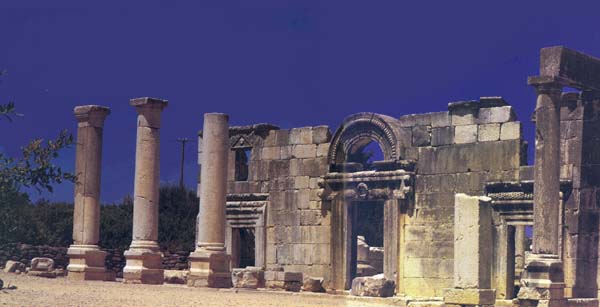
In 70 C.E. Roman legions destroyed the Jerusalem Temple, Judaism’s holiest structure and the “dwelling place of God’s name.” Despite this loss, Judaism was to survive and prosper. In the following centuries, the synagogue itself came to be seen as a “holy place.”
Does this mean, as some people suppose, that the synagogue as we know it developed after the destruction of the Temple and was, in fact, its replacement? Not exactly. Communal meeting places that we can recognize as synagogues existed while the Temple still stood, at least by the mid-first century B.C.E. The second part of the question—Did the synagogue replace the Temple?—is not so easily answered.
The origins of the synagogue are shrouded in mystery, and scholarly opinions as to its beginnings vary. Some scholars trace its development to the First Temple period, others to the Exile in Babylonia, and still others (including the author) to the latter Second Temple period in Palestine. Virtually all scholars recognize that the synagogue was a well-developed institution at least a century before the Romans destroyed the Temple. Synagogues in the Land of Israel are mentioned by the Jewish philosopher, exegete and communal leader Philo of Alexandria (c. 20 B.C.E.-40 C.E.); by the first-century C.E. Jewish historian Flavius Josephus; in the New Testament; and in rabbinic literature.
Archaeology provides additional evidence for the early dating of the origins of the synagogue. In 1913–1914, the French archaeologist Raymond Weill, exploring just south of the Temple Mount, found an ancient water cistern from which he recovered a Greek inscription describing the life of a synagogue community in the holy city while the Temple still stood:
Theodotus, son of Vettenos the priest and synagogue leader (archisynagogos), son of a synagogue leader and grandson of a synagogue leader, built the synagogue for the reading of the Law (Torah) and studying of the commandments, and as a hostel with chambers and water installations to provide for the needs of itinerants from abroad, which his fathers, the elders and Simonides founded.1
For the Greek-speaking Jews who frequented this Jerusalem synagogue during the late first century B.C.E. or the first century C.E., it was a place where they could experience religion in a way very different from, yet complimentary to, what was available to them in the Temple.

Let’s imagine what it was like to make a pilgrimage to the Temple. To enter the Jerusalem Temple a Jewish pilgrim would have had to purify him- or herself through immersion in a ritual bath (miqveh)—perhaps even in the “water installations” mentioned in the Theodotus inscription. Together with Jews from as far away as Spain, the Black Sea region and Persia, our pilgrim would have ascended to the great Temple of Herod, a short walk to the north, to participate in the public sacrifice and pageantry that were the hallmark of the Temple. Our pilgrim would have been a participant-observer in the Temple service. The rituals of the Temple were carried out by the priests and the Levites.
The religious experience of the synagogue was quite different. In Hebrew, the synagogue is called a beth ha-knesset, literally “house of assembly.” The Greek sunagoge means much the same thing. In Theodotus’s synagogue, located in the shadow of the Temple, the assembled community would have read Scripture and studied the commandments. As in synagogues scattered throughout Israel and the Diaspora during this period, the central cultic activity in this Jerusalem synagogue was the reading and study of Scripture called ho nomos, “the Law” in the Greek of our inscription. At Masada, a desert fortress destroyed shortly after the Temple, biblical scrolls were found in close proximity to the synagogue—suggesting that the reading of Scripture was an important feature of synagogue activity. Philo’s description of the synagogues in Alexandria provides an insightful parallel to the Theodotus inscription: “You sit in your groups [conventicles] and assemble your regular company and read in security your holy books, expounding any obscure point and in leisurely comfort discussing at length your ancestral philosophy.”2
An early rabbinic text reflects on how easily a Second Temple period Jew, such as our pilgrim, could move from Temple to synagogue and back again. This text describes the festival of Sukkot (Tabernacles), when the ceremony of the Water Drawing was performed at the Temple:
Said Rabbi Joshua son of Hananiah: All the days of the celebration of the Water Drawing we never saw a moment of sleep. We would arise in time for the morning daily whole-offering [in the Temple].
From there we would go to the synagogue,
From there to the additional [mussaf]
offering [in the Temple],From there to eating and drinking,
From there to the study house,From there to the Temple for the whole sacrifice at dusk,
From there to the celebration of the Water Drawing.3
Interestingly, Second Temple period sources do not mention synagogues as places of prayer. This might come as a surprise to many who are accustomed to a modern synagogue. Evidently, either prayer did not take place in synagogues at this time or the role of prayer in synagogue life was dwarfed by the study of Scripture.
While the Temple still stood, a new kind of religious experience developed within the synagogue that paralleled the age-old cult of the Temple. Local communities came together in synagogues to encounter the divine in the intimate fellowship of like-minded Jews. Those Jews who assembled or perhaps lodged in Theodotus’s synagogue could move almost effortlessly from communal Torah study to the offering of sacrifices at the Temple, with no sense that these institutions were in any way in competition for their loyalty.
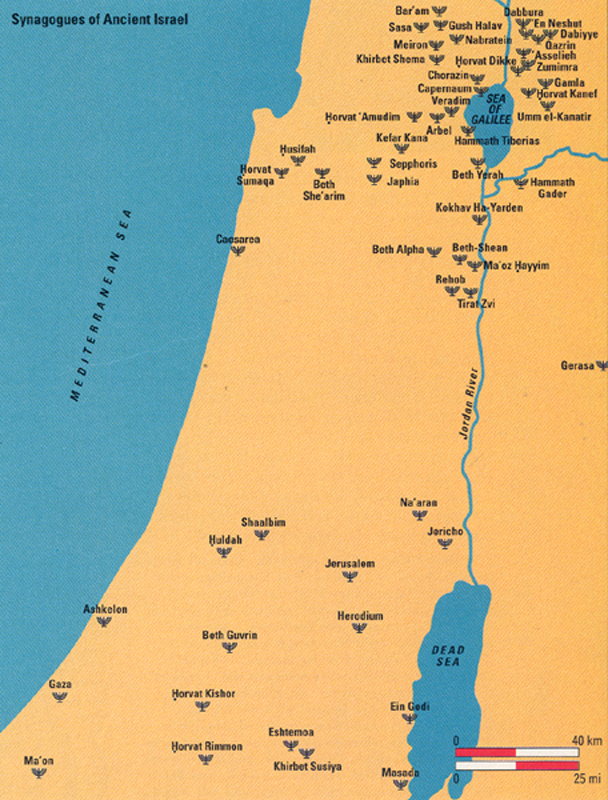
Still, the synagogue did represent a new approach to Judaism, one that was closely related in form to the Greco-Roman collegea. In the Land of Israel, this change appears to have occurred after the conquest of Palestine in 332 B.C.E. by Alexander the Great, and perhaps even after the Maccabean Revolt of 168–164 B.C.E. Like adherents of other religions, Jews in Greco-Roman Palestine assembled in self-defined communities where they developed religious practices that were more intimate than those of the great civic religion of the Jerusalem Temple.
The Temple was regarded as the center of the universe, the navel of the world—what the great historian of religion Mircea Eliade called the axis mundi between the sacred and the profane. Synagogues, on the other hand, were local places where Jews came together to study Scripture, through which they gained access to the revealed word of God. While the Temple still stood, the synagogue was a complementary, not a competitive, institution.
What of the period after the destruction of the Temple? Did the synagogue then replace the Temple?
No doubt the destruction of Herod’s Temple created an unparalleled religious challenge. Not since the destruction of Solomon’s Temple in 586 B.C.E. had Jewish communities faced such a religious trauma. The early rabbinic sages (the Tannaim) met this challenge by stressing those elements of Judaism that had survived the destruction of the Temple. For example, the teaching aspect of the Passover meal (the Seder) was emphasized, and the Pascal sacrifice, which was the focal point of the Passover evening in Second Temple times, was played down.
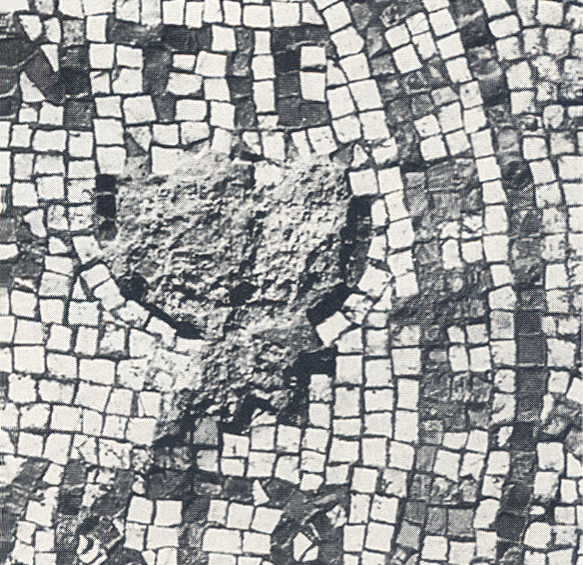
Similarly, Torah study, rather than the Temple service, became the most important religious act of the Jew; study was seen as the essential vehicle for knowing God’s will. The synagogue, the focal point for communal study, thus took on added significance. This “house of assembly” became the institutional focal point for the tannaitic reconstruction of Judaism.
Slowly, the religious significance of the synagogue expanded. The meeting house of the Second Temple period was gradually transformed over the coming centuries into a holy place, though contemporaneous Jews never explicitly thought of it as a replacement of the lost Temple.
Synagogues were associated with the Temple in numerous early rabbinic sources. Biblical verses referring to the Temple were read as including synagogues. For example, in Leviticus 26:31, “I will destroy your temples [miqdasheihem],” the word “temples” was interpreted by the sages to include synagogues and study houses [batei midrash] in God’s eternal plan.4 The synagogue was thus incorporated into sacred time.
The synagogue’s relationship to the Temple was sometimes suggested in subtle ways in early rabbinic sources. For example, the sages decreed that a synagogue destroyed by no fault of the community should be treated with respect—a parallel of the respect demanded for the now-destroyed Temple Mount. The sages deemed it inappropriate to use the ruins of synagogues as shortcuts, because synagogues “remain sacred even when they are destroyed.”5
Beginning with the Tannaim of the late first and second centuries C.E., synagogues were no longer exclusively places of study; they became places of prayer as well. Prayer was instituted as a thrice-daily regime corresponding to the times sacrifices had been offered in the Temple.
The central prayer of the rabbinic liturgy, today called the Amidah, was recited facing Jerusalem—a reflection of the continuing centrality of the Temple in Jewish life. Similarly, one tradition suggests that the Torah cabinet was set on the wall opposite the holy city, aligned toward the Temple of God.a
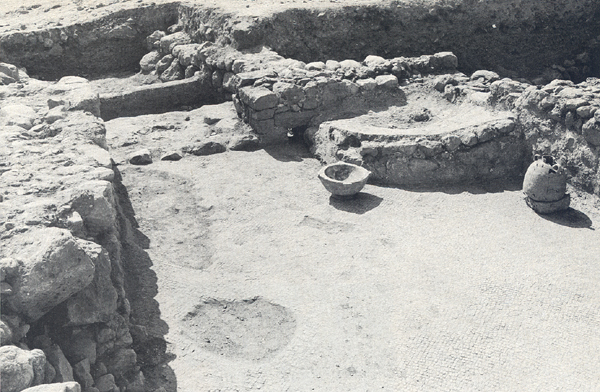
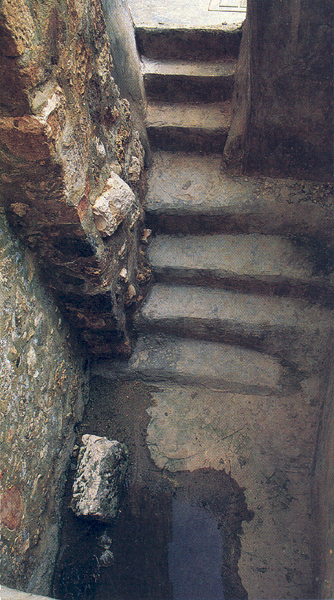
Just as the Temple was the divine residence, so prayer brought the divine presence to the synagogue: “Whenever ten people congregate in the synagogue the divine presence is with them.”6 By the third century, some sages held that the status of synagogue prayer was so great that, according to the Jerusalem Talmud, “He who prays in the synagogue is like one who sacrifices a pure meal offering [minhah].”7
The rabbinic sages also drew on Temple imagery in referring to the synagogue, but only in a provisional way. Synagogues were but pale reflections of the Jerusalem Temple; they were not in direct competition with it. The real danger was that synagogues might become alternatives to the Temple in the wake of its destruction. Alternative temples existed even during the latter Second Temple period—at Heliopolis in Egypt, in Samaria and perhaps at Beth El. To ensure the distinctive character of the Temple, some early sources warned that neither seven-branched menorahs like those of the Temple nor cherubim (which rested above the Ark of the Covenant in Solomon’s Temple) should be set up in synagogues. A complementary relationship between the Temple and synagogues was constructed by emphasizing the sanctity of synagogues as places of Torah, while expressing this sanctity in forms reminiscent of the more deeply sacred Temple. As time passed and the memory of the Temple became more distant, the synagogue began to be called a “holy place,” a “holy house” and even a “small temple.”8
A similar development can be seen in the chest that housed the Torah and other biblical books in the synagogue. In early rabbinic (tannaitic) literature, it is called a teva. In the Bible, the box in which the infant Moses floats down the Nile is a teva. By the second century C.E., however, “teva” refers to chests used for many different purposes. In the succeeding centuries, the Torah chest is called an arona, Aramaic for “ark.” In a dedicatory inscription found in an ancient synagogue in Naveh (modern Nawa, in Syria), a dedicatory inscription calls the Torah shrine a beit arona, literally “house of the ark.”9 In the Bible, the Ark of the Covenant, which was the centerpiece of the Tabernacle and Solomon’s Temple, is the aron ha-berit, or “ark of the covenant.” According to literary sources and artistic representations of Torah arks, the synagogue Torah chest was a tall cabinet, sometimes, according to one text, divided into upper and lower sections. The scrolls were laid on shelves in the cabinet, in the way that scrolls were generally stored in the Greco-Roman world.10 The Torah ark sometimes had a curtain in front of it, called a vilon or parokhta. Some connected this curtain with the parokhet that separated the Holy of Holies from the main hall of the Temple.
In one ancient source, a rabbi made the connection between the Torah ark in the synagogue and the Ark of the Covenant in the Temple quite explicitly. On a fast day, Rabbi Huna the Greater of Sepphoris lamented that the assembled community covered the Torah ark with ashes as a sign of mourning, as their forefathers had covered the Ark of the Covenant with gold.11
On the other hand, the rabbis were careful not to confuse the Torah ark with the Temple Ark. According to some traditions, the Ark of the Covenant would be restored to the Temple during messianic times. The Torah shrine, by contrast, like the synagogue itself, could be sold as a commodity. The Torah ark was a holy object in the synagogue, an institution whose sacredness was this-world bound—pale in comparison to the eternally sacred “House of God.”
As time progressed, more and more behaviors and images reminiscent of the Temple were applied to synagogues. One particularly interesting text comes from the famous genizah of the Ben Ezra synagogue in Cairo,b which housed documents that, though copied during the middle ages, preserve texts dating to the Byzantine and even the Roman periods. In this text, synagogue worshipers are admonished to wash their hands and feet before entering, and the synagogue itself is referred to as a “small temple”:
The sages said: “One shall not enter the Temple Mount with his staff and shoes” [Mishnah Berakhot 9.5]. Though by our sins the Temple Mount is not ours, we do have the “small temple [the synagogue],” and we are obligated to behave [toward it] with sanctity and awe. For it is written: “My temple, fear” [Leviticus 19:30, 26:2]. Therefore the ancients decreed in all synagogue courtyards that lavers of living water for the sanctification of the hands and feet [be set up].12
A water installation that may have been used for hand and foot washing was found just inside the entrance to the sixth-century synagogue excavated at Ein Gedi, on the shore of the Dead Sea. Washing the hands and feet and entering holy places barefooted were common religious practices in late antiquity, as they are today in Islam. Hand washing when entering a synagogue is still practiced by some Jews.
Yet, architecturally, no synagogue looked anything like the Temple. Remains of over a hundred synagogue buildings from the third to the eighth centuries C.E. have been uncovered in the Land of Israel. The Temple built by Herod was a massive structure that integrated biblical and early Second Temple period traditions with the architectural traditions of imperial Rome. Synagogue architecture, on the other hand, had more in common with the public basilicas and churches of the late Roman and Byzantine periods than with the Temple. The synagogues that have been excavated were mostly large, roofed halls designed to accommodate worshipers who gathered in them for public ritual. The Temple shrine was not meant for the public. The pious assembled faithfully on the Temple Mount platform and in the porticoes that surrounded the shrine.
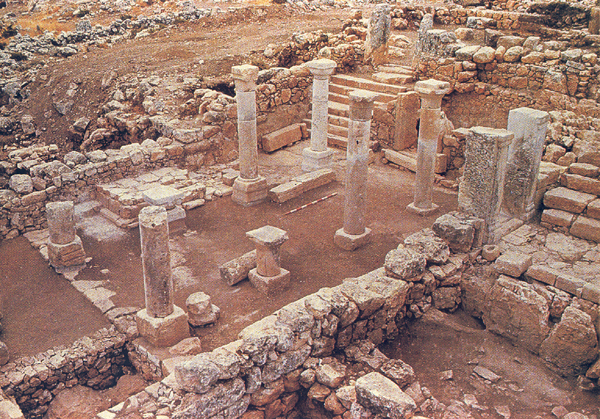

Three basic architectural plans were used in synagogues. The broad-house type, a large meeting house with a podium supporting a Torah shrine on its wide, Jerusalem-facing wall, is known from Khirbet Shema in the upper Galilee and from the Judean hill country south of Hebron. The “Galilean Basilica” developed in the area north of the Sea of Galilee. This type is best known from the synagogues of Capernaum and Bar’am. The facades of these synagogues faced Jerusalem and had three large portals. These buildings bear a striking resemblance to Christian church architecture in Syria. The third group, characterized by a long-house basilica with an apse at one end, is found in the Jordan Rift valley, lower Galilee and the coastal plain. In long-house basilicas, a podium with a Torah shrine standing on it was built opposite the entrance, on the wall aligned with Jerusalem. The arrangement of the apsidal basilica was taken over directly from Christian church architecture.
What unites all of these buildings is their focus on the community, the fact that most were oriented toward Jerusalem and that most had large Torah shrines.
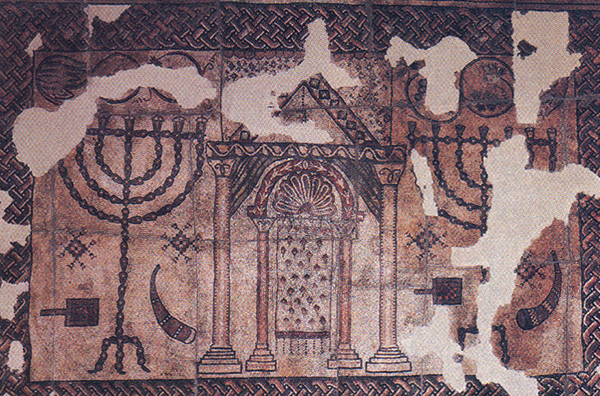

A number of synagogues, especially of the third type, were paved with mosaics that depicted the Torah ark. One especially famous example is from the synagogue at Beth Alpha; similar depictions have been found in mosaic synagogue floors at Hammath Tiberias (fourth century), Naaran (fifth-sixth centuries) and Beth-Shean (sixth century). In the synagogues at Beth Alpha, Naaran and Beth-Shean, the mosaic panel was laid before the apse. The Torah shrine on the mosaic floor of the synagogue at Beth Alpha is topped by two birds and flanked by two seven-branched menorahs and two rampant lions.
Scholars have long debated what is represented in this mosaic panel. Some, including Eleazar L. Sukenik, who excavated Beth Alpha in the late 1920s, believe it is a reflection of the actual furnishings of the Beth Alpha synagogue apse. This is certainly right. All of the elements illustrated have been recovered in synagogue excavations. A similar Torah shrine pediment was discovered by Eric M. Meyers and Carol Meyers in a synagogue at Nabratein. Large stone menorahs were found in synagogues at Hammath Tiberias and Maon, in Judea. A large lion was discovered at Chorazin, and cloth curtains likethe one represented in the mosaic from Beth-Shean are mentioned in rabbinic literature.
So what is the answer to our original question? Did the synagogue in Palestine of late antiquity replace the Temple? Another text from the Cairo Genizah relates that “as long as the Temple existed, perpetual sacrifices and offerings would atone for the sins of Israel. Now synagogues are unto Israel in place of the Temple. As long as Israel prays in them, their prayers are in place of the perpetual sacrifices and offerings.”13
This seems like a genuine doctrine of “replacement.” The text, however, still sets the Temple as the standard of true religion, as the source of “atonement” in the ideal world. If synagogue ritual is conducted properly, the tradition argues, we “will see the rebuilding of the Temple and [the reestablishment of] the perpetual sacrifices and offerings.”14 Within the synagogue, the centrality of Torah study and prayer remained a constant. Even in the Cairo Genizah text, which contains the only explicit statement of replacement that I know of, the replacement is provisional. As long as the Temple is in ruins, the text tells us, the only sure way of communing with the divine is through synagogue prayer. The passage quoted above continues:
[By reciting] prayers at their proper time and directing their hearts, they [will] merit and will see the rebuilding of the Temple and [the reestablishment of] the perpetual sacrifices and offerings, as it is said: “And I will bring them to my holy mountain and I will rejoice in my house of prayer” [Isaiah 56:7]. Their sacrifices and offerings will be received well on my altar, “for my house shall be called a house of prayer for all of the nations.
Citing the prophet Isaiah, this writer refers to the Temple as a “house of prayer.” The homilist of this tradition chose to emphasize this verse precisely because it serves as a bridge between the synagogue as a current house of prayer and the Temple as the eternal house of prayer.
The answer to our question is complex. At no time was the synagogue a serious threat to the centrality and sanctity of the Temple. In the centuries after 70 C.E., as hopes for the Temple’s imminent rebuilding dimmed, the synagogue as an institution blossomed and became, in itself, a Sacred Realm.
For Jews, the synagogue became the bridge between the loss of their cosmic center and the hope for the rebuilding of the Temple. In the synagogue, they concentrated their religious hopes, praying, in the words of an ancient sage, that “the Temple [be] rebuilt, speedily in our day.
MLA Citation
Footnotes
A genizah is a place, usually attached to a synagogue, where objects bearing the name of God are stored when they become unusable. According to Jewish law, such articles may never be destroyed; hence the genizahs of some synagogues contained large collections of manuscripts. See Raphael Levy, “First ‘Dead Sea Scroll’ Found in Egypt Fifty Years Before Qumran Discoveries,” BAR 08:05.
Endnotes
Lea Roth Gerson, Greek Inscriptions in Synagogues and the Land of Israel (Jerusalem: Ben Zvi Institute, 1987; in Hebrew), pp. 76–86. See also Howard Clark Kee, “The Transformation of the Synagogue after 70 C.E.: Its Import for Early Christianity,” New Testament Studies 36 (1990), p. 8; and Richard E. Oster, Jr., “Supposed Anachronism in Luke-Acts’ Use of Sunagoge: A Rejoinder to H.C. Kee,” New Testament Studies 39 (1993), pp. 178–208.
For the “small temple”: Babylonian Talmud Megillah 29a; for the “holy house”: Targum Neofiti, Genesis 11:1, 31:47, 32:2 and parallels.
Joseph Naveh, “The Aramaic and Hebrew Inscriptions from Ancient Synagogues,” Eretz-Israel 20 (1989; in Hebrew), p. 307.
Steven Fine and Miriam Della Pergola, “The Synagogue of Ostia and Its Torah Shrine,” in The Jewish Presence in Ancient Rome, ed. Joan Goodnick Westenholz (Jerusalem: Bible Lands Museum, 1995), pp. 52–57.
Hilkhot Eretz Israel min-ha-Genizah, ed. Mordecai Margaliot (Jerusalem: Rav Kook Institute, 1973), pp. 131–132.
Louis Ginzberg, Genizah Studies in Memory of Doctor Solomon Schechter, vol. 1 (New York: Jewish Theological Seminary of America, 1928; in Hebrew), pp. 152–153.
